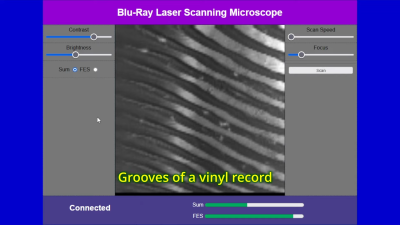Laser scanning microscopes are useful for all kinds of tiny investigations. As it turns out, you can build one using parts salvaged from a Blu-ray player, as demonstrated by [Doctor Volt].
 The trick is repurposing the optical pickup unit that is typically used to read optical discs. In particular, the build relies on the photodiodes that are usually used to compute focus error when tracking a disc. To turn this into a laser scanning microscope, the optical pickup is fitted to a 3D printed assembly that can slew it linearly for imaging purposes.
The trick is repurposing the optical pickup unit that is typically used to read optical discs. In particular, the build relies on the photodiodes that are usually used to compute focus error when tracking a disc. To turn this into a laser scanning microscope, the optical pickup is fitted to a 3D printed assembly that can slew it linearly for imaging purposes.
Meanwhile, the Blu-ray player’s hardware is repurposed to create a sample tray that slews on the orthogonal axis for full X-Y control. An ESP32 is then charged with running motion control and the laser. It also captures signals from the photodiodes and sends them to a computer for collation and display.
[Doctor Volt] demonstrates the microscope by imaging a small fabric fragment. The scanned area covers less than 1 mm x 1 mm, with a resolution of 127 x 127, though this could be improved with finer pitch on the slew mechanisms.
While it’s hardly what we’d call a beginner’s project, this technique still looks a lot more approachable than building your own scanning electron microscope.

















He sounds like rainier wulfcastle.
Impressive hack however!
A microscope made from a media player? Now THIS is a hack!
Agree
A Blu-Ray’s laser at optimal focus will put a few milliwatts into a fraction of a square micron area, or about 10 kilowatts per square millimeter. About 200,000 times the power density of the surface of the sun.
A blu-ray disc survives this is because it’s moving fast under that laser spot: the exposure time for any given spot is 0.1 microseconds.
So what happens to a substrate when you dwell on it with this rig? Can you record pits into vinyl records?
I mean it’s easy to say that it’s impressively powerful when you scale it up that way, but in actual practice I’d bet the minute amount of thermal energy instantly dissipates into the surrounding matter for most materials. It might burn through the thin metal film in a blu-ray disk if it dwells. I don’t think it’ll become a laser engraver of any use.
If you figure out a way to replicate that on a square meter surface, please contact DARPA
Aside from ablating substrate, what advantage does scanning a spot confer over just taking a picture with a microscope?
My ancient far-from-current-state microscope can yield resolutions around a micron, 2000 (real) pixels per millimeter.
So, it’s not resolution driving the reason for this to exist. What can it do that an ordinary microscope can’t?
(“ordinary” microscopes these days can do epi-illumination too, so that’s not a reason)
The advantage is that you can yank this out of an old piece of garbage as opposed to paying a lot of money for even a third-rate old microscope I’m guessing
I think its also smaller than a corresponding microscope?
It can measure the 3D heights (within the focus distance), instead of relying on color / amount of light reflection.
A scanning microscope can get more magnification than a normal compound one without loosing details
The blu-ray OPU is very versatile:
Compact, low-cost Blu-Ray pickup-based digital holographic microscope, https://www.sciencedirect.com/science/article/abs/pii/S0143816622003256
Optical resolution photoacoustic microscopy using a Blu-ray DVD pickup head, https://www.researchgate.net/publication/269323619_Optical_resolution_photoacoustic_microscopy_using_a_Blu-ray_DVD_pickup_head
Hacking CD/DVD/Blu-ray for Biosensing, https://pubs.acs.org/doi/full/10.1021/acssensors.8b00340
Micro and nanoscale 3D printing using optical pickup unit from a gaming console, https://www.nature.com/articles/s42005-021-00532-4
Vinyl records great, but can it ‘read’ cds? ;)
Wouldn’t the spatial resolution improve if he used just one of the sensors instead of the sum of the four?
The optical train is designed to perfectly focus the laser onto the center of the 4-way sensor, and elongates diagonally as it loses focus. The quadrature essentially acts as a single sensor when taking the output as a whole, but by applying some maths and baking that equation into an RF chip which generates an output in the opposite direction of a discrepancy any deviation from perfectly centered auto-magically drives the floating lens carrier to correct the focus and alignment of the beam on the disk and the returned light on the detectors. Oh, and it does it in real time as the deviation is detected! Also, IIRC, bluray uses a astigmatic lens early in its optical path that makes 2 guide beams which either fall on the ‘flat area between tracks, or just barely skims the previous and next track. If you look at the detector package on blueray optical pickups youll see the center square and a pair of rectangles on either side. The signal from these rectangles is used for higher precision positioning of the laser path. AND ITS ALL AUTO-MAGIC!!! Seriously, the methods of sensing and control in optical disk players are incredibly clever and efficient. The chip on the actual optical section of the sled doesnt really do much. Mainly constant current source for the laser(s), and the opamp/rf chains for the path correction. But to directly answer your question; nah, I doubt it. The optical pickups entire reason for being is keeping that dot perfectly focused on the middle of the quad-photodetectors.